Deployment Order
CDK Express Pipeline determines deployment order based on a hierarchical structure of Waves, Stages, and Stacks. Understanding this order is crucial for designing efficient pipelines and troubleshooting deployment issues.
Deployment Order Rules
Section titled “Deployment Order Rules”The Wave, Stage and Stack order follows these rules:
- Waves are deployed sequentially, one after the other
- Stages within a Wave are deployed in parallel by default, unless configured to be sequential
- Stacks within a Stage are deployed in order of stack dependencies within a Stage
When used with cdk deploy '**' --concurrency 10, it will deploy all stacks in parallel, 10 at a time,
where possible while still adhering to the dependency graph.
Visual Example
Section titled “Visual Example”For example, the following definition of Waves, Stages and Stacks:
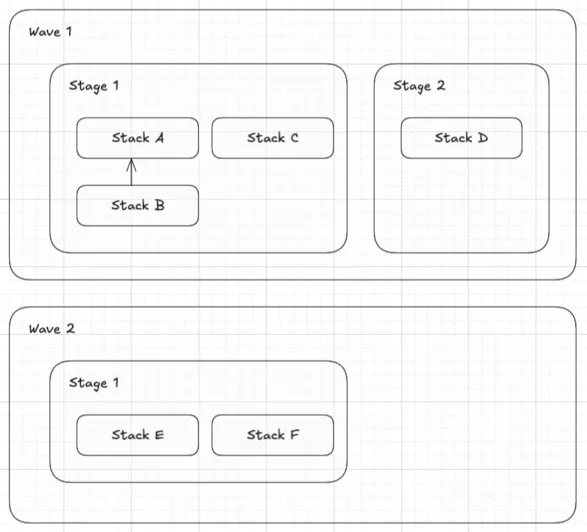
Will create a dependency graph as follows:
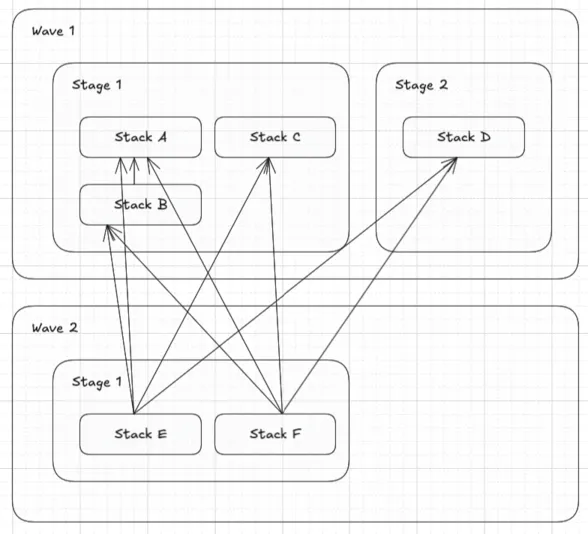
✨✨✨ DEPLOYMENT ORDER VISUALIZED STEP-BY-STEP ✨✨✨
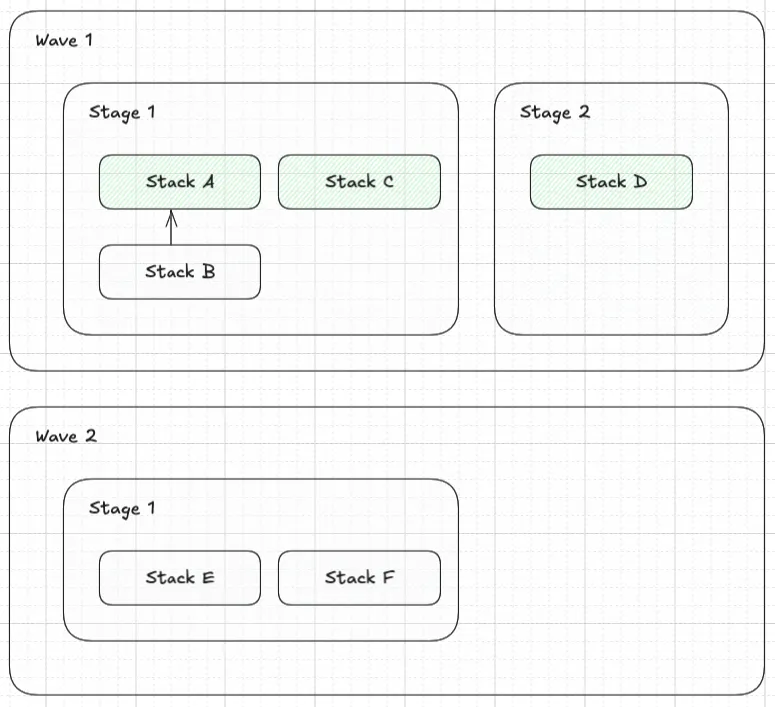
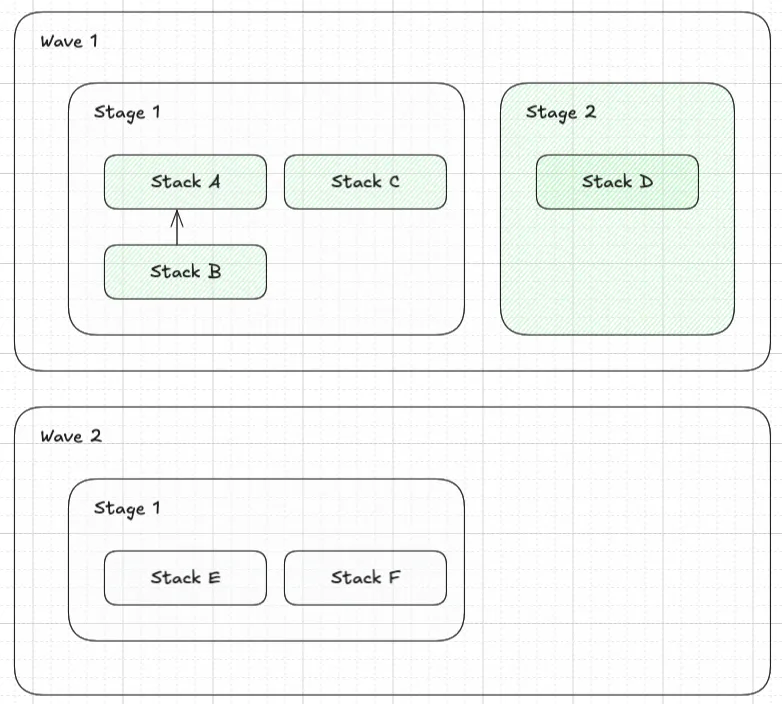
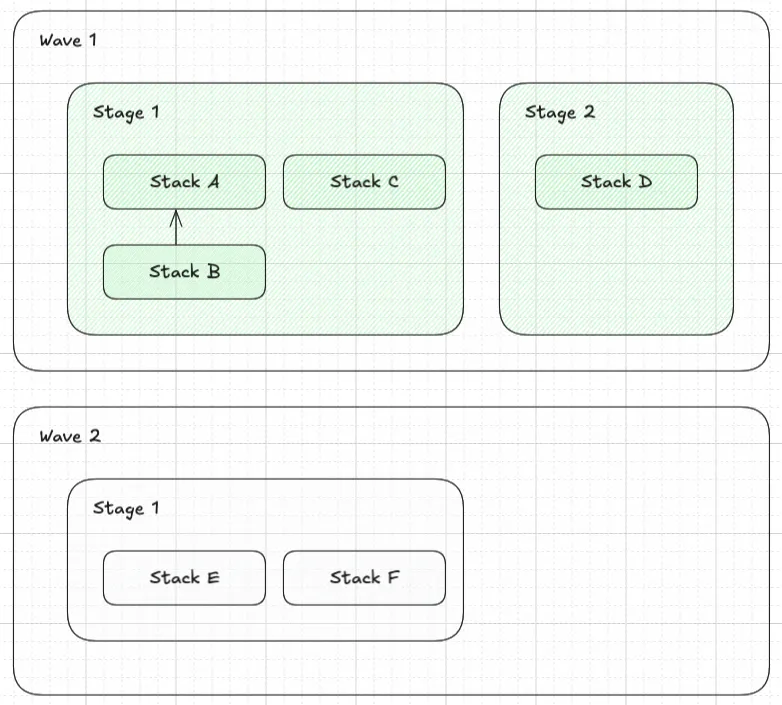
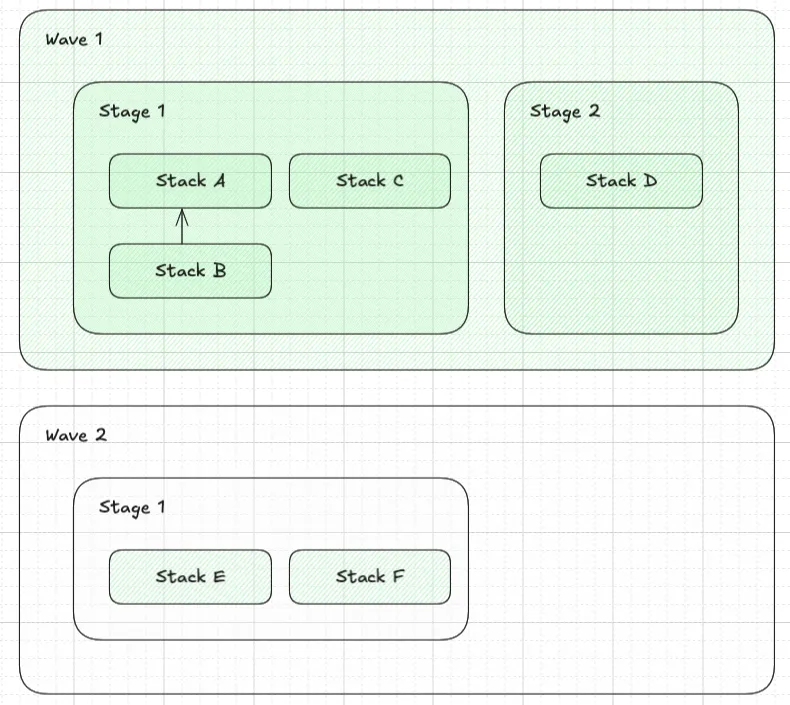
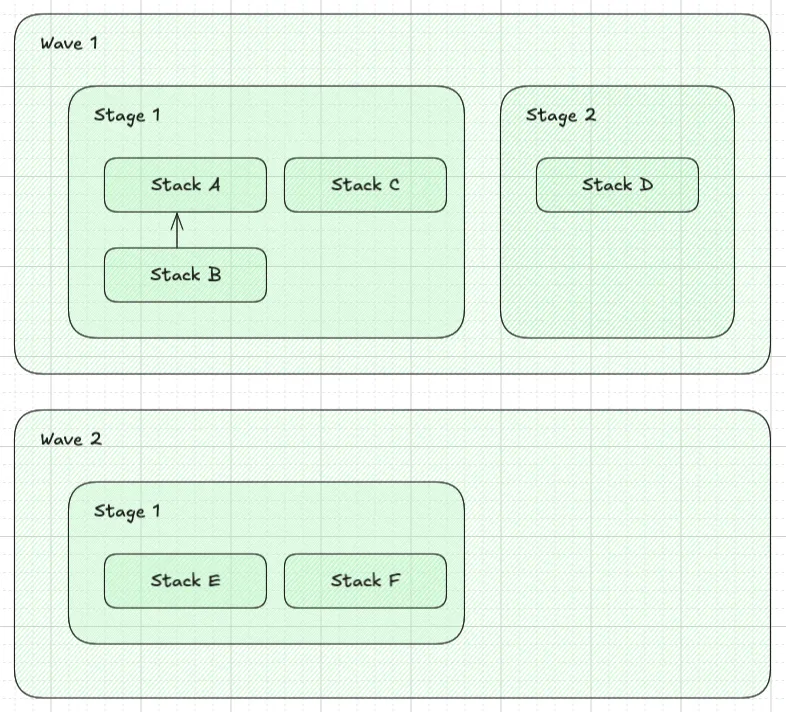
Outputs
Section titled “Outputs”CLI Console message
Section titled “CLI Console message”The CLI Console message is enabled by default when running pipeline.synth. This can be disabled by passing false to the
print argument in the synth function:
expressPipeline.synth([wave1, wave2], false);Let’s use an example of a pipeline that features all possible display options:
Verbal explanation of the output
There are three waves. Waves run sequentially. Within each wave, stages run in parallel unless marked [Seq 🏗],
which only Wave3 is. Stacks in a stage deploy in the order based on their dependencies, shown with arrows (↳),
and their position in the deployment order is indicated with square brackets like [1].
Wave1 has two stages. In Stage1, StackA and StackF (shown by [1]) deploy first. StackB, StackC, and
StackE ([2]) follow, all depending on earlier stacks. StackD ([3]) is last, depending on StackB and StackF.
Stage2 runs in parallel and deploys StackA and StackB ([1]) first, followed by StackC ([2]), which depends
on StackB.
Wave2 has two stages, all stacks ([1]) in both stages deploy at the same time since they have no dependencies.
Wave3 is marked [Seq 🏗], so its stages run one after another. Stage1 deploys StackL and StackM ([1]) at
the same time, and then Stage3 deploys StackN and StackO ([1]).
The stack selector (ID) is shown in parentheses next to each stack. For example, Wave1 Stage1 StackA has the
selector Wave1_Stage1_StackA. Since every line begins with a pipe (|), we can infer that the command used
was cdk (diff|deploy) '**', meaning all stacks are targeted with this command. We could instead have targeted
a specific wave, stage or stack by using a command like cdk (diff|deploy) 'Wave1_Stage1_*', which would only
deploy the stacks in Wave1 Stage1.
ORDER OF DEPLOYMENT🌊 Waves - Deployed sequentially.🏗 Stages - Deployed in parallel by default, unless the wave is marked `[Seq 🏗]` for sequential stage execution.📦 Stacks - Deployed after their dependent stacks within the stage (dependencies shown below them with ↳). - Lines prefixed with a pipe (|) indicate stacks matching the CDK pattern. - Stack deployment order within the stage is shown in square brackets (ex: [1])
| 🌊 Wave1| 🏗 Stage1| 📦 StackA (Wave1_Stage1_StackA) [1]| 📦 StackB (Wave1_Stage1_StackB) [2]| ↳ StackA| 📦 StackC (Wave1_Stage1_StackC) [2]| ↳ StackA| 📦 StackD (Wave1_Stage1_StackD) [3]| ↳ StackB, StackF| 📦 StackE (Wave1_Stage1_StackE) [2]| ↳ StackF| 📦 StackF (Wave1_Stage1_StackF) [1]| 🏗 Stage2| 📦 StackA (Wave1_Stage2_StackA) [1]| 📦 StackB (Wave1_Stage2_StackB) [1]| 📦 StackC (Wave1_Stage2_StackC) [2]| ↳ StackB| 🌊 Wave2| 🏗 Stage1| 📦 StackH (Wave2_Stage1_StackH) [1]| 📦 StackI (Wave2_Stage1_StackI) [1]| 🏗 Stage2| 📦 StackJ (Wave2_Stage2_StackJ) [1]| 📦 StackK (Wave2_Stage2_StackK) [1]| 🌊 Wave3 [Seq 🏗]| 🏗 Stage1| 📦 StackL (Wave3_Stage1_StackL) [1]| 📦 StackM (Wave3_Stage1_StackM) [1]| 🏗 Stage2| 📦 StackN (Wave3_Stage2_StackN) [1]| 📦 StackO (Wave3_Stage2_StackO) [1]Mermaid Diagram
Section titled “Mermaid Diagram”The Deployment Order can also be outputted to a markdown file containing a Mermaid graph. This option is
disabled by default, and can be enabled when running the pipeline.synth. The output defaults to the root of
the project with the filename pipeline-deployment-order.md, but this can be changed in the function arguments.
expressPipeline.synth( [wave1, wave2], true, // CLI Console output enabled, { } // Enable Mermaid output with default path);Verbal explanation of the Mermaid output
There are three waves. Waves run sequentially. Within each wave, stages run in parallel unless indicated by an
arrow, which only Wave3’s stages are. Stacks in a stage deploy in the order based on their dependencies, shown
with arrows, and their position in the deployment order is indicated with square brackets like [1].
Wave1 has two stages. In Stage1, StackA and StackF (shown by [1]) deploy first. StackB, StackC, and StackE
([2]) follow, all depending on earlier stacks. StackD ([3]) is last, depending on StackB and StackF. Stage2
runs in parallel and deploys StackA and StackB ([1]) first, followed by StackC ([2]), which depends on StackB.
Wave2 has two stages, all stacks ([1]) in both stages deploy at the same time since they have no dependencies.
Wave3 is marked [Seq 🏗], so its stages run one after another. Stage1 deploys StackL and StackM ([1]) at the
same time, and then Stage3 deploys StackN and StackO ([1]).
The stack selector is shown in parentheses next to each stack. For example, Wave1 Stage1 StackA has the selector
Wave1_Stage1_StackA. Since every line begins with a pipe (|), we can infer that the command used was
cdk (diff|deploy) '**', meaning all stacks are targeted with this command. We could instead have targeted a
specific wave, stage or stack by using a command like cdk (diff|deploy) 'Wave1_Stage1_*', which would only
deploy the stacks in Wave1 Stage1.